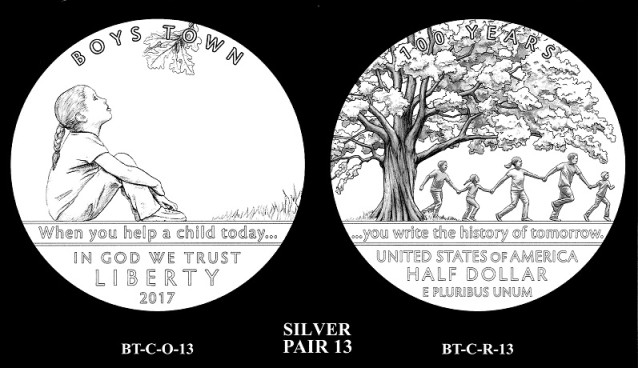Boys Town Commemorative Coin Set is a First

At its March meeting in Washington DC, the Citizens Coinage Advisory Committee (CCAC) considered the designs for a three coin set—gold $5, silver $1, and clad $1/2 dollar—to commemorate the one hundredth anniversary of Boys Town. It was the first time that obverses and reverses were paired by artist for presentation to the committee.
Instead of presenting coin designs as separate obverses and reverses to be voted on by the CCAC and the Commission on Fine Arts (CFA) and paired together by them, the Mint encouraged its artists to design a complete coin and consider the round metal palate as a four dimensional object. The CFA will review the designs presented in this format for the first time as well during its meeting this week.
It may well have been the most complicated coin program the CCAC considered in a decade, but his was not due to the pairings. There were over thirty good designs for all three denominations and the sponsoring organization was very involved in the design process from the beginning. Their representatives worked with the artists and attended CCAC meetings to challenge us to help them select a set of coins that would both tell the story of Boys Town and attract buyers beyond the U.S. Mint’s collector base.
March, 2016 was not the first time the top people from Boys Town came to Washington DC about their commemorative coin program. They had been to Capitol Hill many times to lobby members of Congress to adopt a bill and to secure the support of the President of the United States to sign the bill.
By law, there can only be two commemorative coin programs a year. Many groups lobby Congress to get a commemorative coin program. Not only does it mean that their group or favorite person will be immortalized on a United States coin, but it could mean substantial fundraising dollars in the form of a surcharge for the sponsoring organization.
The surcharge can result in big dollars for the host organization if the coins sell, but commemorative coins do not always sell very well. Many commemorative coins have low mintages like the 2013 Five Star General coin program that sold 160,000 of the $1 and $1/2 dollar coins in both proof and uncirculated and 19,157 of the gold proof and uncirculated coins. That was a particularly unattractive set of portrait coins without much support from collectors or from members of the sponsoring organization.
As a base line, it can be estimated that “hard core” collectors, repeat buyers of US Mint Commemoratives, account for about 30,000 to 40,000 buyers of clad and silver and about 4,000 to 5,000 buyers of the gold coins. The “hard core” will buy one each of the uncirculated and proof. Collectors will buy these coins every year just to keep their collection complete. Unfortunately for the sponsoring organizations, this is not enough for the U.S. Mint to recapture their costs. To get a surcharge, the coins must sell enough so the Mint breaks even before the surcharge kicks in.
Pretty coins sell. The 2014 Baseball National Hall of Fame coin sold over 250,000. This did not happen just because baseball is popular or because the sponsoring organization pushed the coin. This happened because the coin was interesting and popular. The cup shaped clad $1/2 received the Krause Coin of the Year Award for world coins minted in 2014. The silver dollar baseball coin received the Krause award for “Best Crown.”
Ugly coins do not sell. While the Girl Scouts of America might be great at selling cookies, they could not sell their ugly commemorative silver dollar. Only 115,822 out of the 350,000 maximum mintage of both the proof AND uncirculated coins were sold. The Girl Scouts of America got the coin design they wanted, but few people bought it.
The sponsoring organization very often needs to make a choice—either commemorate the organization in a traditional way, or pick creative designs that can sell beyond the “hard core” collector base and make money for the organization through the surcharge. Boys Town wanted to do both and they put in the time and let go of their original pre-conceived notions of what a commemorative coin should look like to accomplish it.
Boys Town still got the portrait they wanted of Father Edward J. Flanagan, but the portrait is on the lower mintage gold coin. The fact that each coin in the three coin set is designed by the same artist for the first time in the modern commemorative coin series will be a selling point. In addition, the silver dollar design has a lot of potential to become very popular.
The Silver dollar coin design recommended by the CCAC illustrates the use of the fourth dimension—time. The obverse shows a child sitting alone, gazing into the branches of an oak tree as if to seek help. The empty space in the field creates the sense of loneliness and isolation. Flip the coin to the reverse and the full oak tree only hinted at by a few of its leaves on the obverse is revealed as a full grown tree providing shelter and the foundation of a family scene that includes the girl depicted on the obverse. By a creative use of both sides of the coin, the story is complete and the coin has visual and emotional depth as a work of art.
As of the date this was posted, the coin designs discussed and illustrated in this article are the recommendations’ of the Citizens Coinage Advisory Committee ONLY. All of the proposed designs are also reviewed by the Commission on Fine Arts and the final designs are selected by the Secretary of the Treasury. While the CCAC has a good track record with the Secretary, the final design decision is his and his alone.
